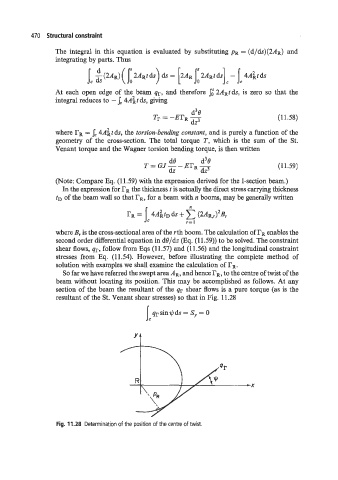Page 489 - Aircraft Stuctures for Engineering Student
P. 489
470 Structural constraint
The integral in this equation is evaluated by substituting p~ = (d/ds)(2A~) and
integrating by parts. Thus
At each open edge of the beam qr, and therefore $ 2ARtds, is zero so that the
integral reduces to - Jc 4Ait ds, giving
(1 1.58)
where rR = sc 4Ait ds, the torsion-bending constant, and is purely a function of the
geometry of the cross-section. The total torque T, which is the sum of the St.
Venant torque and the Wagner torsion bending torque, is then written
de d3 8
T = GJ- - ErR 7 (1 1.59)
dz dz
(Note: Compare Eq. (1 1.59) with the expression derived for the I-section beam.)
In the expression for rR the thickness t is actually the direct stress carrying thickness
tD of the beam wall so that rR, for a beam with n booms, may be generally written
n
where B, is the cross-sectional area of the rth boom. The calculation of rR enables the
second order differential equation in dO/dz (Eq. (1 1.59)) to be solved. The constraint
shear flows, qr, follow from Eqs (1 1.57) and (1 1.56) and the longitudinal constraint
stresses from Eq. (1 1.54). However, before illustrating the complete method of
solution with examples we shall examine the calculation of rR.
So far we have referred the swept area AR, and hence rR, to the centre of twist of the
beam without locating its position. This may be accomplished as follows. At any
section of the beam the resultant of the qr shear flows is a pure torque (as is the
resultant of the St. Venant shear stresses) so that in Fig. 11.28
IC qr sin $ds = Sy = 0
Fig. 11.28 Determination of the position of the centre of twist.

